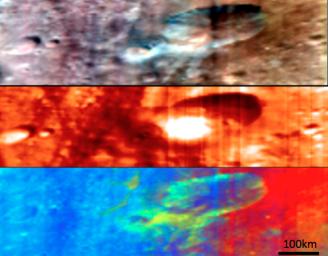
|
Craters and Ejecta in Visible and Infrared Wavelengths
- Click the image above for a larger view
- Full-Res JPEG (727 x 568) (48.9 kB)
- Full-Res TIFF (727 x 568) (1.2 MB)
Caption:
Above are three different composite images of the same region of Vesta's surface. These images were produced by combining images obtained by the Visible and Infrared Imaging Spectrometer (VIR) instrument aboard NASA's Dawn spacecraft. The VIR instrument can image Vesta in many different wavelength regions, called bands, in the near ultraviolet, visible and infrared parts of the electromagnetic spectrum, which corresponds to a wavelength range of 300nm to 5000nm. The top image is a RGB composite simulated true color image where red is set as the 700nm band, green is set as the 550nm band and blue is set as the 440nm band. The wavelength of red light is around 700nm, of green light is around 550nm and of blue light is around 440nm, so this image approximates what the human eye would see looking at Vesta. The middle image is taken in the infrared part of the spectrum and shows the thermal emission of Vesta's surface; the light colors correspond to the hottest temperatures and the dark colors correspond to the coldest temperatures. The bottom image is another RGB composite image in which bands from the visible and infrared were combined to enhance the differences in the composition of Vesta's surface. In the case of this bottom image different colors correspond to characteristics of the composition of the surface. Different compositions can help to identify regions which have undergone different geological processes. For example, in the bottom image the green ejecta blanket of the crater on the right is very distinctive against the blue and red surface of the rest of Vesta. This ejecta blanket is much harder to identify in the other images.
NASA's Dawn spacecraft obtained the images used to make these composite images with its Visible and Infrared Imaging Spectrometer on August 8th 2011. The distance to the surface of Vesta is 2740km and the average image resolution is 800 meters per pixel.
Background Info:
The Dawn mission to Vesta and Ceres is managed by NASA's Jet Propulsion Laboratory, a division of the California Institute of Technology in Pasadena, for NASA's Science Mission Directorate, Washington D.C. UCLA is responsible for overall Dawn mission science. Dawn's VIR was provided by ASI, the Italian Space Agency and is managed by INAF, Italy's National Institute for Astrophysics, in collaboration with Selex Galileo, where it was built.
More information about Dawn is online at http://www.nasa.gov/dawn and http://dawn.jpl.nasa.gov .
Cataloging Keywords:
| Name | Value | Additional Values |
|---|---|---|
| Target | 4 Vesta | |
| System | Main Belt | |
| Target Type | Asteroid | |
| Mission | Dawn | |
| Instrument Host | Dawn | |
| Host Type | Orbiter | |
| Instrument | Visible and Infrared Spectrometer (VIR) | |
| Detector | ||
| Extra Keywords | Color, Crater, Infrared, Magnetosphere, Thermal, Ultraviolet | |
| Acquisition Date | ||
| Release Date | 2011-10-29 | |
| Date in Caption | ||
| Image Credit | NASA/JPL-Caltech/UCLA/ASI/INAF/IASF/IFSI | |
| Source | photojournal.jpl.nasa.gov/catalog/PIA14976 | |
| Identifier | PIA14976 | |
